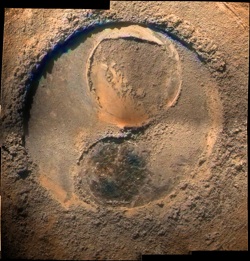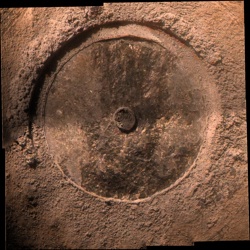No, no. Trust me, my "real life" is about as far from being a comedian as you can get.
Full Version: Post Block Island Meteor Studies (The Western Route)
Haha! I wish!
No, no. Trust me, my "real life" is about as far from being a comedian as you can get.
No, no. Trust me, my "real life" is about as far from being a comedian as you can get.
Some interesting bits of information on the status report covering sols 2111-2117, Dec. 31, 2009 - Jan. 6, 2010:
"The rock abrasion tool (RAT) was used to grind a 1.5-millimeter-deep (0.06-inch-deep) hole in this very hard rock at the target called "Peck Bay 2." The alpha particle X-ray spectrometer (APXS) measurements of Peck Bay 2 were significantly different than the pre-grind measurements. Based on these results, Opportunity is spending another week at Marquette Island for more observations of Peck Bay 2."
"The rock abrasion tool (RAT) was used to grind a 1.5-millimeter-deep (0.06-inch-deep) hole in this very hard rock at the target called "Peck Bay 2." The alpha particle X-ray spectrometer (APXS) measurements of Peck Bay 2 were significantly different than the pre-grind measurements. Based on these results, Opportunity is spending another week at Marquette Island for more observations of Peck Bay 2."
This is VERY interesting. The pre-grind surface "looked" pretty clean, but if there is a significant difference in APXS readings after the grind, then there may be a patina of "desert varnish" or the like on this rock, maybe a very thin hydration layer. The pre-to-post grind APXS difference will be very enlightening. I hope someone (pretty please...) drops a hint about what the difference is....
Very low imaging activity for me, but quite interstings things to do with colors and mosaics of Marquette Island RAT.
So, a colorized view of the RAT on Sol 2110 :

And on Sol 2116 (from a color view of Sol 2117) :

Regarding the structure and the texture, yes, it's an interesting rock
So, a colorized view of the RAT on Sol 2110 :

And on Sol 2116 (from a color view of Sol 2117) :

Regarding the structure and the texture, yes, it's an interesting rock
according to Squyres it is the most interesting rock in 4 or 5 years...
are we there yet?
are we there yet?
Yahoo! We're out of here! 
Drive Drive Drive! Carbonates are calling us!



Drive Drive Drive! Carbonates are calling us!
QUOTE
Yahoo! We're out of here!
Where did you hear that?
Not yet but maybe in a few hours...



02122::p0693::03::6::0::0::6::0::12::navcam_3x1_az_162_3_bpp
...
02122::p1211::03::2::0::0::2::0::4::ultimate_front_haz_1_bpp_pri_15
...
02122::p1312::07::2::0::0::2::0::4::rear_haz_ultimate_2_bpp_pri15
...
02122::p2355::21::12::0::0::12::2::26::pancam_drive_direction_4x1_L6R12
02122::p0693::03::6::0::0::6::0::12::navcam_3x1_az_162_3_bpp
...
02122::p1211::03::2::0::0::2::0::4::ultimate_front_haz_1_bpp_pri_15
...
02122::p1312::07::2::0::0::2::0::4::rear_haz_ultimate_2_bpp_pri15
...
02122::p2355::21::12::0::0::12::2::26::pancam_drive_direction_4x1_L6R12
I noticed what may have been a wind event in some MIs that came down recently. This is from sol 2110 and the MIs are of the first RAT site (Peck Bay 1?) on Marquette Island. We can see numerous dust clumps and sand grains moving between two images taken 83 seconds apart, just before 1 PM Mars time. File name time stamps and MMB calculated Mars times are annotated in the lower right corner. I have rotated the images 180 degrees to display them in their upright orientation.
It is interesting to note that most of the grains move in a generally upward direction, which is why I am assuming the movement is due to a wind event and not simply the result of grains falling off the face of the rock. I was wondering if this could be caused by static discharge, but that seems unlikely on a rock that is obviously grounded.
Click to view attachment
It is interesting to note that most of the grains move in a generally upward direction, which is why I am assuming the movement is due to a wind event and not simply the result of grains falling off the face of the rock. I was wondering if this could be caused by static discharge, but that seems unlikely on a rock that is obviously grounded.
Click to view attachment
I wonder if there is a way to make a 3-D image of the crystal structure using these grind pictures, since we have pictures of a couple of different layers?
Have we now left Marquette? Can't spot it on the latest hazcams...
Cosmic Rocker, darned interesting little animation you've put together!
A few final 3D views...
http://twitpic.com/ydtc3
http://twitpic.com/ydti5
http://twitpic.com/ydtqp
Farewell Marquette!
http://twitpic.com/ydtc3
http://twitpic.com/ydti5
http://twitpic.com/ydtqp
Farewell Marquette!
Marquette abstracts are out:
http://www.lpi.usra.edu/meetings/lpsc2010/pdf/2109.pdf
http://www.lpi.usra.edu/meetings/lpsc2010/pdf/2109.pdf
More patches than strips... The only problem may be getting a good spectrometer reading. But the brushed surface alone looks so clean... that I wonder if the reading would be much different a couple millimeters down anyway.
Interesting comments about the Marquette grind in the latest planetary society report. Squyres says that even though the brushed surface looks clean, the composition is actually very different inside. So that made it hard to get good readings:
QUOTE
“We would have liked to blast right into it, making a 5,6,7-millmeter grind to put a deep RAT hole where you would blow any weathering layer across the entire RAT hole and put on the APXS and get one good measurement. The problem is we don't know how much grind capability we’ve got left and we think it's not much. Moreover, it turned out we were correct that Marquette Island is an extremely hard rock and a good hard grind could have taken the instrument out completely.”
But they were able to compensate:
QUOTE
the rover would take several different measurements at different parts of the RAT hole. “You assume you're seeing a mixture of surface and subsurface material in different proportions depending on where you're measuring. So, by taking multiple measurements and connecting a line between them you can both interpolate and extrapolate and learn quite a bit about what the composition of the individual end members are, especially since we know what the surface material looks like already,” Squyres explained. “We did that and are in the process of doing the calculations.”
This is a "lo-fi" version of our main content. To view the full version with more information, formatting and images, please click here.
